If you’re aiming for an immersive flight experience, I recommend exploring top VR flight simulators like REALFLIGHT Evolution RC for realistic flying and multiplayer fun, the Pimax Crystal headset with stunning visuals, and hardware like the Turtle Beach VelocityOne or Logitech G X56 for precise control. A sturdy cockpit like the Marada setup and high-res displays such as WINWING’s make the experience even better. Stay tuned to find out the best mix for your needs.
Key Takeaways
- RealFlight Evolution RC offers immersive VR compatibility with a diverse aircraft fleet for realistic flight simulation.
- Pimax Crystal Light VR provides ultra HD visuals and wide FOV, enhancing immersion in compatible flight sims.
- VelocityOne and Logitech G X56 deliver authentic control experiences with full hardware integration for realistic flight handling.
- Advanced cockpit hardware like WINWING Phoenix MIP replicates full-cabin environments for immersive VR flight training.
- Compatibility with popular titles like Microsoft Flight Simulator and iRacing ensures a wide range of VR flight simulation options.
REALFLIGHT Evolution RC Flight Simulator Software with Interlink DX Controller
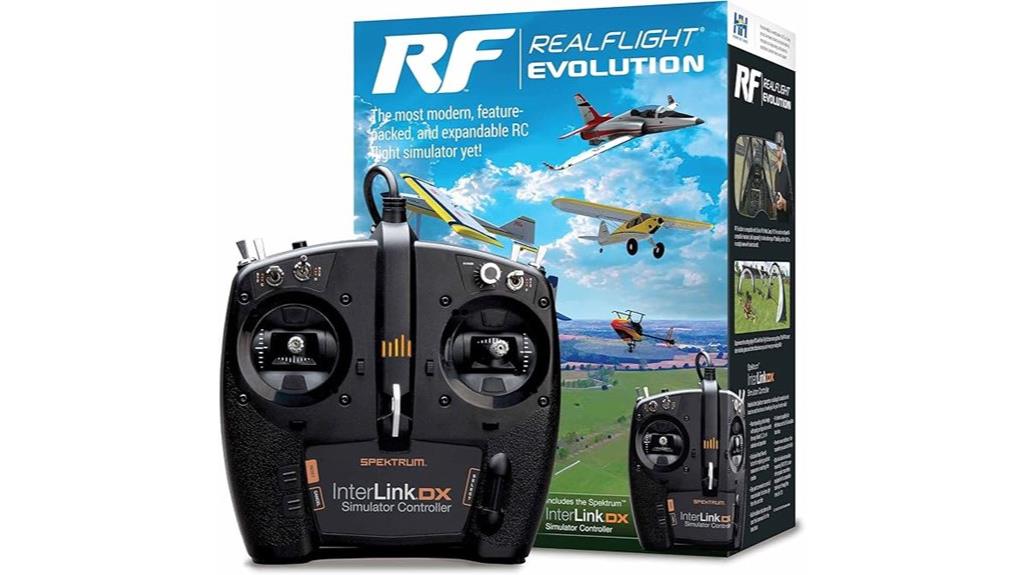
If you’re looking for a realistic RC flight simulation that’s easy to use and highly immersive, REALFLIGHT Evolution with the Interlink DX controller is an excellent choice. Its modern, user-friendly interface makes setup and navigation straightforward, while the compatibility with VR headsets creates an incredibly immersive experience. The included InterLink DX controller reduces reliance on mouse or keyboard, giving you more control and a natural flying feel. With a diverse fleet of aircraft—from micro to scale models—and access to iconic flying sites like the PhotoField from Triple Tree Aerodrome, this simulator offers endless flying fun. Plus, its online multiplayer options connect you with a vibrant RC community.
Best For: RC hobbyists and enthusiasts seeking an easy-to-use, highly immersive flight simulation experience with realistic aircraft models and online multiplayer capabilities.
Pros:
- User-friendly interface with modern design simplifies setup and navigation
- Compatibility with VR headsets enhances immersion for more realistic flying
- Extensive aircraft fleet and flying sites, including iconic locations like the PhotoField
Cons:
- Content updates and additional aircraft/models may require separate purchases or season passes
- Some users might need a VR headset for the full immersive experience, which could involve extra cost
- Online multiplayer features depend on internet connectivity and may have a learning curve for new users
Pimax Crystal Light VR Headset with Controllers

The Pimax Crystal Light VR Headset with Controllers stands out for its ultra HD visuals and wide field of view, making it an excellent choice for flight simulation enthusiasts who demand immersive and realistic experiences. With a resolution of 2880×2880 per eye and AI upscaling, it delivers sharp, smooth visuals that enhance realism. Its large FOV closely mimics natural human vision, boosting immersion. The headset is lightweight and adjustable, ensuring comfort during long flights. Setup is straightforward—just connect to your PC and follow quick instructions. Compatible with popular sims like Microsoft Flight Simulator and iRacing, it’s perfect for elevating your virtual flying adventures.
Best For: VR enthusiasts and flight simulation fans seeking immersive, high-resolution visuals with a comfortable, easy-to-set-up headset.
Pros:
- Ultra HD visuals with 2880×2880 per eye resolution and AI upscaling for sharp, smooth images
- Large field of view that mimics natural human vision, enhancing immersion
- Lightweight design with adjustable comfort for extended use
Cons:
- Requires connection to a PC and initial setup, which may be complex for some users
- Limited to specific compatible VR titles, potentially restricting game options for some users
- 30% lighter than previous models but still may be less comfortable for very long sessions without proper adjustments
Turtle Beach VelocityOne Flight Control System for Xbox and Windows
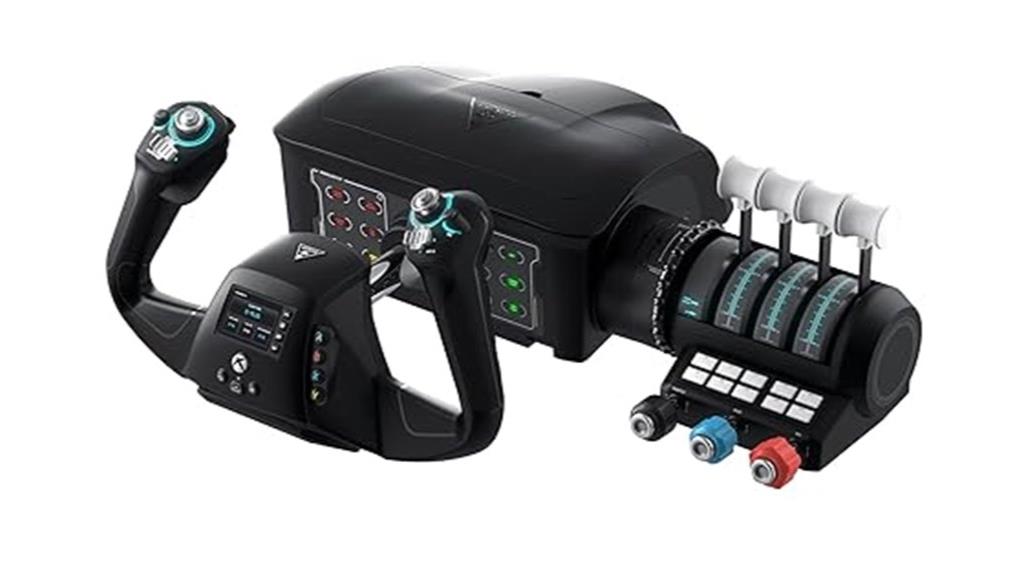
For immersive VR flight simulations on Xbox and Windows, the Turtle Beach VelocityOne Flight Control System stands out with its authentic, all-in-one design that includes a precise yoke, throttle, and rudder controls. Its 180° yoke handle features a non-contact hall effect sensor for smooth, accurate movement, complemented by a dedicated pitch trim wheel and integrated rudder and brake controls. The modular throttle quadrant is customizable, and a full-color flight management display makes setup intuitive. Compatible with titles like Microsoft Flight Simulator 2020 and 2024, this system offers seamless integration, stable clamping, and realistic controls, elevating your VR flight experience to new heights.
Best For: Flight simulation enthusiasts seeking an authentic, versatile, and immersive VR experience on Xbox and Windows platforms.
Pros:
- Supports multiple platforms including Xbox Series X & S, Xbox One, and Windows 10 & 11 for versatile compatibility.
- Features a true-to-life 180° yoke handle with non-contact hall effect sensor for precise control.
- Modular design with customizable throttle quadrant and full-color flight management display for easy setup and personalization.
Cons:
- May require space for proper setup and stable clamping to ensure optimal stability during intense flights.
- The all-in-one design might be complex for beginners to fully configure initially.
- Higher price point compared to basic flight controllers, reflecting its advanced features and realism.
Logitech G X56 H.O.T.A.S Flight Simulator Controller

Designed specifically for serious flight enthusiasts and aspiring combat pilots, the Logitech G X56 H.O.T.A.S Flight Simulator Controller offers military-grade precision and extensive customization options. With 189 programmable controls, RGB lighting, and dual USB connectivity, it’s built for immersive simulation. The controller features precise hall-effect sensors for accurate pitch, roll, yaw, and movement, essential for realistic flying. You can fine-tune tension, force, and throttles to your preference, making it highly adaptable. Compatible with Windows 7 through 11, it integrates seamlessly into VR setups, putting all controls within easy reach. This controller truly elevates your flight experience to a professional level.
Best For: serious flight enthusiasts and aspiring combat pilots seeking military-grade precision and extensive customization in their flight simulation setup.
Pros:
- Highly customizable with 189 programmable controls and adjustable tension settings
- Features accurate hall-effect sensors for precise pitch, roll, yaw, and movement control
- Compatible with Windows 7 through 11 and designed for immersive VR experiences
Cons:
- Requires two USB 2.0 ports, which may limit connectivity for some setups
- Slightly complex configuration process due to extensive customization options
- Larger size and weight might require ample space and stable mounting
Marada Modular Flight & Racing Simulator Cockpit

If you’re serious about immersive flight or racing simulations, the Marada Modular Flight & Racing Simulator Cockpit offers an all-in-one platform that adapts to your needs. Its sturdy construction with thickened square tubes and four-hole flange connections guarantees stability during intense gameplay. The adjustable design lets you customize height, pedal position, and backrest angle for maximum comfort. Compatibility with popular peripherals like Logitech G923, Thrustmaster TX, and G29 makes setup flexible. The breathable, ergonomic red seat adds comfort for long sessions. Whether flying or racing, this versatile cockpit enhances realism and immersion, making it a solid choice for serious sim enthusiasts.
Best For: serious flight and racing simulation enthusiasts seeking a durable, adjustable, and versatile cockpit for immersive gameplay.
Pros:
- Sturdy construction with thickened square tubes and flange connections for excellent stability
- Highly adjustable to customize height, pedal position, and backrest angle for comfort
- Compatible with a wide range of popular gaming peripherals, enhancing versatility
Cons:
- Steering wheels, shift levers, and pedals are not included, requiring additional purchases
- May be bulky and require ample space for setup and storage
- Assembly might be complex for users unfamiliar with assembling simulation equipment
WINWING: Phoenix MIP(VR) Flight Simulator Controller
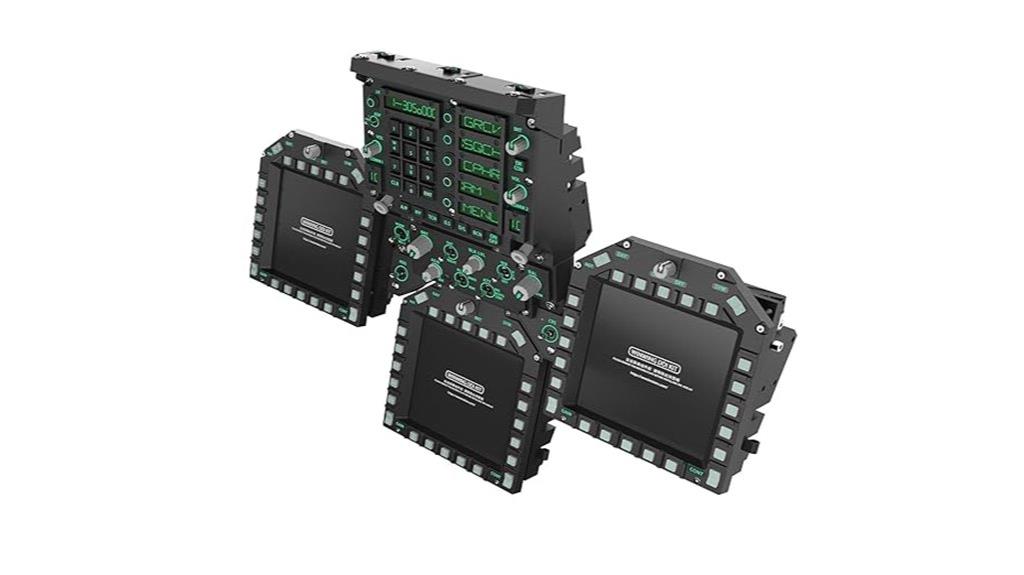
The WINWING Phoenix MIP(VR) Flight Simulator Controller stands out for its highly realistic, full-cabin simulation experience, making it ideal for serious flight enthusiasts and professional pilots alike. It features components like UFC1, MFD1 X3, HUD1, and MP1 X3, working together to replicate a real cockpit. The detailed structural design, textured surfaces, and operational elements like the ascending channel knob enhance authenticity and immersion. Built from high-quality materials, it offers durable, backlit switches, selector switches, and customizable options. The modular setup allows for easy expansion and personalized configurations, while included accessories simplify installation. This controller truly elevates your VR flight sim experience to new heights.
Best For: serious flight simulation enthusiasts and professional pilots seeking a highly authentic, full-cabin VR cockpit experience.
Pros:
- Highly realistic and immersive cockpit design with detailed structural surfaces and textured controls.
- Modular and customizable setup allows for tailored configurations and easy expansion.
- Durable, high-quality materials with backlit switches and precision industrial die key caps for long-lasting use.
Cons:
- May require technical knowledge for installation and configuration.
- The comprehensive setup could be costly and complex for casual users.
- Limited information on compatibility with specific VR systems or flight sim software.
RealFlight Evolution RC Flight Simulator Software (RFL2001)

RealFlight Evolution RC Flight Simulator Software (RFL2001) stands out for its highly realistic air and helicopter flying experience, making it ideal for RC enthusiasts who want authentic simulation. It supports VR headsets and online multiplayer, adding social and immersive dimensions. The intuitive interface uses the InterLink DX controller for smooth, easy controls, reducing the need for keyboard or mouse. With over a dozen aircraft from top brands like E-flite and HobbyZone, plus multiple helicopters, you’ll find plenty of options. The simulator features iconic sites like the PhotoField at Triple Tree Aerodrome and more than 100 models, with regular updates to keep content fresh and engaging.
Best For: RC hobbyists and enthusiasts seeking highly realistic air and helicopter flight simulation with immersive VR support and comprehensive content updates.
Pros:
- Highly realistic flight experience for both air and helicopter models
- Supports VR headsets and online multiplayer for immersive and social flying sessions
- Intuitive interface with the InterLink DX controller simplifies operation and controls
Cons:
- Requires compatible VR hardware for full immersive experience
- Content updates and additional models are sold separately, potentially increasing overall cost
- May have a learning curve for beginners unfamiliar with RC flight simulators
GTPLAYER Folding Gaming Stand for Logitech, Thrustmaster & PXN Devices

For gamers seeking a versatile and durable stand to support their flight and racing devices, the GTPLAYER Folding Gaming Stand stands out as a top choice. It’s compatible with popular models like Logitech G Pro, Thrustmaster T300RS, and PXN devices, offering full adjustability with a 20-degree tilt and over 20cm height adjustment. Made from high-strength carbon steel, it’s built for stability during intense sessions. Its foldable design makes storage easy, and the five fixed wheels plus two sliding ones guarantee stability and mobility. With positive reviews and a strong market presence, it’s an excellent addition to any racing or flight simulator setup.
Best For: gamers seeking a versatile, durable, and space-saving stand to support their flight and racing devices for optimal comfort and stability during gameplay.
Pros:
- Fully adjustable with 20-degree tilt and over 20cm height range for personalized setup
- Constructed from high-strength carbon steel for maximum stability and durability
- Foldable design with wheels allows easy storage and mobility in limited spaces
Cons:
- Racing/flight devices such as wheel, shifter, and pedals are not included
- Slightly heavy at 32 pounds, which may affect portability for some users
- Price and availability can vary, and price matching is not always guaranteed
Thrustmaster TFRP Flight Rudder Pedals for Flight Simulators
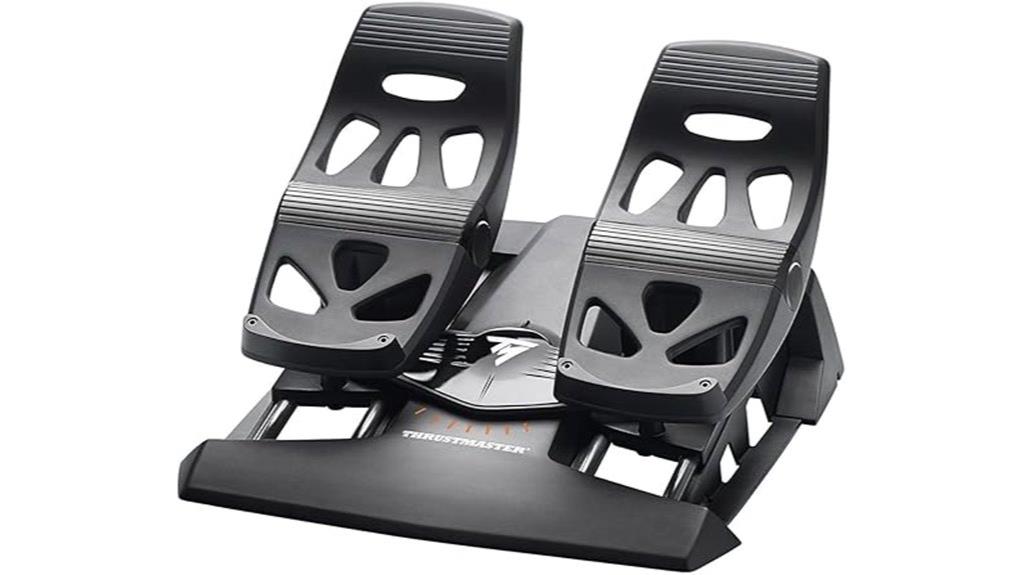
If you’re serious about achieving authentic flight control, the Thrustmaster TFRP Flight Rudder Pedals stand out as a top choice. These pedals offer realistic aviation control with smooth, precise rudder operation. The four industrial-grade aluminum slide rails ensure durability and seamless movement, while the innovative S.M.A.R.T system guarantees stability during intense maneuvers. The long-range rudder axis provides accurate responsiveness, and the self-centering mechanism balances resistance with smoothness for authentic feel. Compatible with PC, Xbox One, and PlayStation 5, these pedals suit both casual and serious flight enthusiasts, elevating your flight simulation experience to new heights.
Best For: flight simulation enthusiasts seeking realistic, durable, and precise rudder controls across PC, Xbox One, and PlayStation 5.
Pros:
- Durable construction with industrial-grade aluminum slide rails for smooth, long-lasting operation
- Innovative S.M.A.R.T system ensures stability during intense maneuvers
- Accurate, responsive rudder axis with self-centering mechanism for authentic feel
Cons:
- May require some setup time to optimize positioning and resistance
- Compatibility limited to specific gaming platforms (PC, Xbox One, PS5)
- Slightly higher price point compared to basic rudder pedals
Logitech G PRO Flight Yoke System, Professional Simulation Yoke and Throttle Quadrant

The Logitech G PRO Flight Yoke System stands out for its highly realistic controls, making it an excellent choice for both serious flight sim enthusiasts and newcomers enthusiastic to experience authentic aircraft handling. Its stainless steel shaft guarantees smooth, precise movement across five axes, with 14 buttons and a POV hat for extensive control options. The included throttle quadrant adds further realism with four configurable controls. Its modular design and sturdy mounting options make setup easy and stable. Compatible with Windows systems and popular flight sim software, this system offers at least 54 programmable controls, delivering a thorough and immersive flying experience for any level of pilot.
Best For: flight simulation enthusiasts seeking a highly realistic and customizable control system for both beginners and experienced pilots.
Pros:
- Highly realistic controls with smooth, precise operation thanks to stainless steel shaft and multiple axes.
- Extensive control options with 14 buttons, POV hat, and configurable throttle quadrant.
- Modular design with easy mounting options ensures stability and straightforward setup.
Cons:
- Requires optional software for full compatibility with some flight simulators.
- May be bulky for limited desk space due to its size and mounting needs.
- Higher price point compared to basic flight control peripherals.
Thrustmaster T-Flight Hotas One Flight Simulator Controller for Xbox and PC

The Thrustmaster T-Flight Hotas One Flight Simulator Controller is an excellent choice for casual gamers and flight simulation enthusiasts who want a versatile, realistic control setup on both Xbox and PC. It features an official Microsoft Flight Simulator license, ensuring seamless compatibility. The controller boasts 10-bit precision, five axes, 14 buttons, a rapid trigger, and a multidirectional hat switch, giving you precise control. Its adjustable resistance joystick and detachable throttle offer customization for different aircraft types and comfort. Plus, the dual rudder system allows for realistic lateral maneuvers. Overall, it combines realism, flexibility, and ease of use, making it a top-tier choice for immersive flight experiences.
Best For: casual gamers and flight simulation enthusiasts seeking a versatile and realistic control setup for Xbox and PC.
Pros:
- Official Microsoft Flight Simulator license ensures seamless compatibility.
- Features 10-bit precision, 5 axes, 14 buttons, rapid trigger, and multidirectional hat switch for precise control.
- Detachable throttle and adjustable resistance joystick offer customization and comfort for various aircraft types.
Cons:
- May require additional accessories for full rudder control, such as the Thrustmaster TFRP rudder.
- Slightly complex setup for beginners unfamiliar with flight controls.
- Limited compatibility with non-Microsoft flight simulation software.
FlightGear Flight Simulator 2025 X on USB
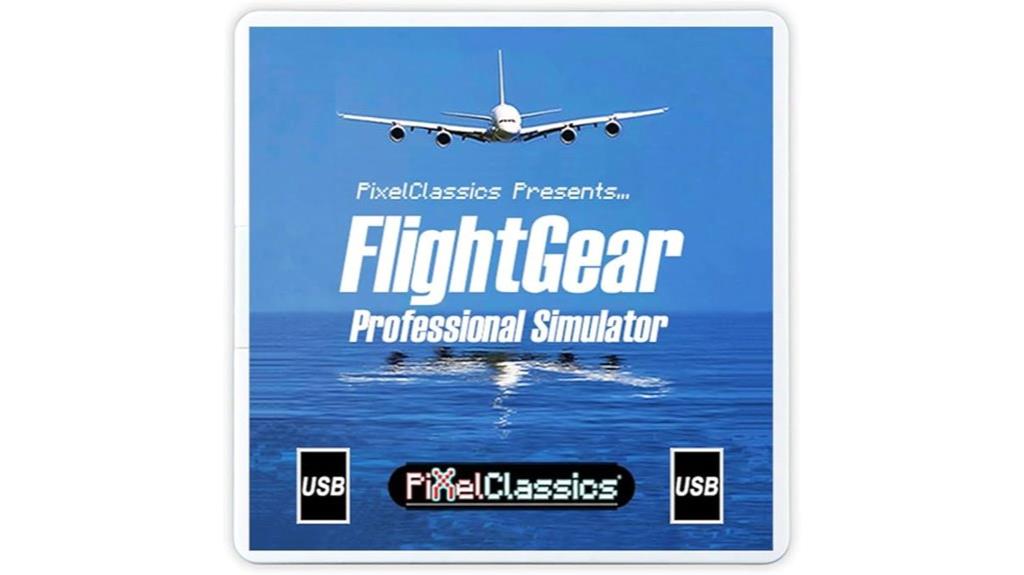
FlightGear Flight Simulator 2025 X on USB stands out as an ideal choice for serious aviation enthusiasts and aspiring pilots seeking a highly realistic experience. It offers extensive global coverage with 20,000 real-world airports, over 600 aircraft types, and ultra-realistic flight physics. Compatible with Windows 11, 10, and earlier versions, it connects easily via a USB device, not a disc. Designed for professional use, it includes detailed environments, an all-encompassing manual, and regular updates. This simulator demands a capable system, but it delivers unmatched realism, making it perfect for those serious about mastering aviation in a virtual setting.
Best For: Serious aviation enthusiasts and aspiring pilots seeking a highly realistic and comprehensive flight simulation experience on Windows PC.
Pros:
- Extensive global coverage with 20,000 real-world airports and over 600 aircraft types for diverse flying experiences
- Ultra-realistic flight physics and detailed environments that enhance training and immersion
- Includes comprehensive manual, bonus aircraft, and regular updates to ensure ongoing value and support
Cons:
- Requires a high-performance system with at least quad-core CPU, 6GB RAM, and 2048MB VRAM GPU, which may not be suitable for older hardware
- Delivered as a USB device rather than a physical disc, which might be inconvenient for some users
- Steep learning curve due to professional-grade features, necessitating careful reading of the manual to operate effectively
Pimax Crystal VR Headset Partial Payment Version

If you’re serious about immersive flight simulation, the Pimax Crystal VR Headset Partial Payment Version stands out with its ultra-high resolution and wide field of view, offering a visually stunning experience. With 3840×3840 resolution per eye and a 127° (or 138° in Labs mode) FOV, it delivers crisp visuals and expansive immersion. It features glass aspheric lenses, vivid colors, and supports dynamic foveated rendering, making details pop. The headset includes comfortable adjustable IPD, built-in headphones, microphones, and controllers. Plus, you can test it at home with a risk-free 14-day trial and pay only a deposit upfront, with full payment due if you’re satisfied.
Best For: VR enthusiasts seeking ultra-high resolution and an expansive field of view for immersive flight simulations and gaming.
Pros:
- Exceptional 3840×3840 per eye resolution delivers stunning clarity and detail.
- Wide 127° (138° Labs mode) field of view enhances immersion.
- Includes comfortable adjustable IPD, built-in headphones, microphones, and controllers for a complete VR experience.
Cons:
- Requires a wired connection to a PC, limiting portability.
- Full payment is due after the trial period, which may be a concern for some users.
- Higher price point of $936 USD may be a barrier for budget-conscious buyers.
WINWING USB3.0 Instrument Display (x3) High-Resolution IPS Flight Simulator Displays
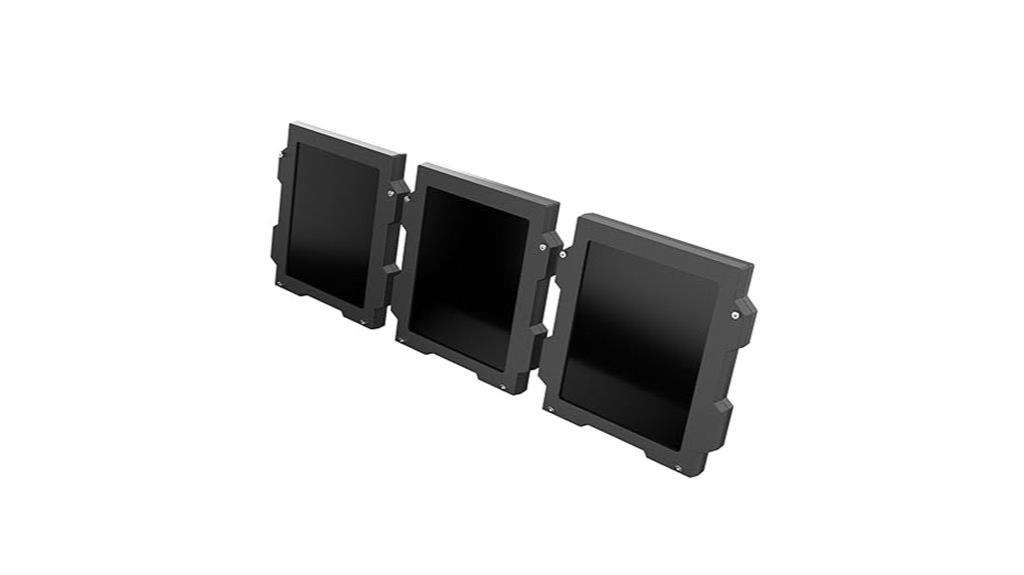
For serious flight simulation enthusiasts seeking realistic instrumentation, the WINWING USB3.0 Instrument Display set offers a standout solution. It includes three high-resolution IPS monitors with a 1024×768 resolution, delivering clear, wide views essential for immersion. These displays connect seamlessly via USB 3.0, freeing up graphics card ports, and support plug-and-play with all Windows flight sims. The built-in USB graphics chips ensure smooth visuals, while features like one-click switching among custom panels add versatility. Crafted from durable materials, they’re designed for long-term use. The integrated setup allows simultaneous monitoring of multiple flight parameters, enhancing overall realism and operational efficiency in your cockpit.
Best For: serious flight simulation enthusiasts and professionals seeking realistic, high-quality instrumentation displays for their cockpit setups.
Pros:
- High-resolution IPS screens with 1024×768 clarity for immersive visuals
- USB 3.0 connectivity ensures easy, plug-and-play setup without occupying graphics card ports
- Durable construction with stable design suitable for long-term, intensive use
Cons:
- Limited resolution at 1024×768 may not meet advanced visual realism standards for some users
- Requires compatible Windows systems and specific flight simulation software for optimal performance
- The three-monitor setup may demand ample space and proper mounting solutions in the cockpit
Diycockpit Wefly G1000 Flight Simulator Hardware Interface
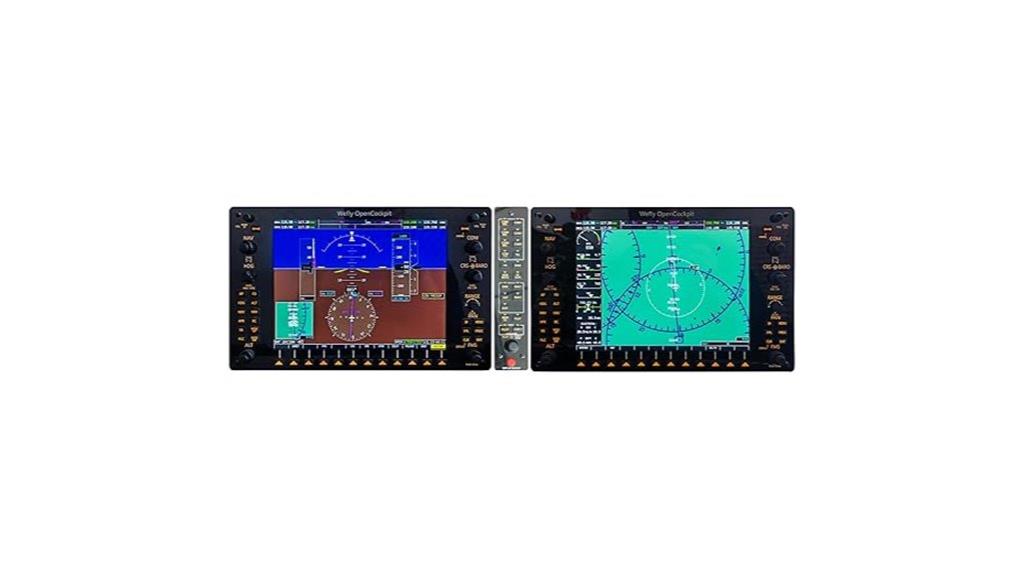
The Diycockpit Wefly G1000 Flight Simulator Hardware Interface stands out for enthusiasts who want a highly realistic cockpit experience. It supports popular flight sims like X-Plane v11/12 and MSFS 2020 with perfect compatibility, making setup straightforward. The hardware features ultra-realistic backlit silicone rubber buttons, high-quality tactile knobs, and bright HDMI displays at 1024×768 resolution. Connecting it is simple with USB and HDMI ports—just guarantee you have two spare HDMI slots or use an HDMI to USB 3.0 adapter. Fully assembled and ready to use, it can integrate with existing panels or sit on a desktop, elevating your flight sim immersion.
Best For: flight simulator enthusiasts seeking a highly realistic and fully compatible G1000 cockpit hardware interface for X-Plane, MSFS 2020, and other major flight sims.
Pros:
- Supports popular flight sims like X-Plane v11/12 and MSFS 2020 with perfect compatibility
- Ultra-realistic backlit silicone rubber buttons and high-quality tactile knobs enhance immersion
- Bright HDMI displays (1024×768 resolution) provide clear, detailed visuals
Cons:
- Requires two spare HDMI ports; may need HDMI to USB 3.0 adapters for some setups
- Limited support for older flight sims such as FSX and Prepar3D v2–v5
- Fully assembled, may limit customization or modifications for advanced users
Factors to Consider When Choosing VR Flight Simulators

When selecting a VR flight simulator, I focus on visual fidelity to guarantee an immersive experience, but I also consider hardware compatibility to avoid connectivity issues. Comfort and ergonomics matter too, since long sessions can cause fatigue, and I want software content variety to keep things interesting. Ultimately, I check system performance requirements to make sure my setup can handle the simulator smoothly.
Visual Fidelity Importance
High visual fidelity is essential in VR flight simulators because it directly impacts how realistic and immersive the experience feels. Sharp, detailed cockpit displays and environments boost immersion and improve training accuracy. Resolutions of 2880×2880 per eye and a field of view over 120° enhance spatial awareness, making flights feel more natural. Technologies like local dimming and AI upscaling deliver clearer images, deeper blacks, and higher contrast, adding to authenticity. Accurate color reproduction and vivid imagery are vital for reading instruments and understanding visual cues. Higher pixels per degree, such as 35 PPD, minimize pixelation and screen door effects, resulting in smoother visuals. These aspects combine to create a more convincing, engaging experience that truly captures the essence of flying.
Hardware Compatibility Needs
Choosing the right VR flight simulator involves more than just visual quality; hardware compatibility plays a vital role in delivering a smooth and realistic experience. First, you need to guarantee your PC or console’s specs meet the VR headset’s requirements, including GPU, CPU, and the necessary USB ports. Compatibility between the flight software and your specific headset model is essential to avoid glitches. Also, check the system’s minimum and recommended specs for peak performance and visuals. Tracking technology is another key factor—whether inside-out cameras or external base stations—that must work seamlessly with your setup. Finally, verify the physical connections, like HDMI, DisplayPort, or USB, to make sure your hardware supports them without issues. Proper compatibility guarantees a hassle-free, immersive flight simulation.
Comfort and Ergonomics
Comfort and ergonomics are crucial factors that can make or break your VR flight simulation experience. A comfortable headset with adjustable IPD ensures clear visuals tailored to my eye spacing, reducing eye strain. I look for lightweight designs with balanced weight distribution, so I can fly longer without fatigue. Ergonomic controllers with customizable grips help me maintain control and prevent hand fatigue during extended sessions. High refresh rates of 90Hz or above, combined with low latency, minimize motion sickness and boost immersion. Adjustable straps and padding are essential for a secure fit, accommodating different head sizes and alleviating pressure points. Prioritizing these ergonomic features ensures that I stay comfortable and focused, making every flight more enjoyable and less distracting by physical discomfort.
Software Content Variety
When evaluating VR flight simulators, the variety of software content plays a essential role in enhancing realism and engagement. A wide selection of aircraft models—ranging from fixed-wing planes and helicopters to jets—expands training options and makes the experience more authentic. Diverse environments, including airports, open fields, and cityscapes, provide practical settings for different scenarios. Regular updates and expansion packs keep the simulator fresh, adding new aircraft, terrains, and features that reflect real-world developments. Compatibility with user-generated content allows customization, letting you tailor aircraft and scenery to your preferences. Additionally, a broad array of pre-designed missions and scenarios helps improve skills and keeps practice sessions engaging. All of these factors combine to make the software content an essential element in choosing the best VR flight simulator.
System Performance Requirements
To enjoy a smooth and immersive VR flight simulation experience, your system’s performance capabilities need to meet specific requirements. First, guarantee your PC meets the minimum hardware specs, including a high-performance CPU, at least 8GB of RAM, and a powerful GPU with enough VRAM to handle high-resolution graphics without lag. Check that your VR headset’s refresh rate and resolution are compatible with your system’s graphics to prevent stuttering or display issues. Make sure your system supports necessary connections like USB 3.0 for data transfer and HDMI or DisplayPort for video output, ensuring seamless integration. Also, consider the processing power needed for features like AI upscaling and foveated rendering, which boost visuals but demand more from your GPU. Keep your drivers and VR software updated for peak performance.
Immersion and Field of View
A wider field of view (FOV) in VR flight simulators considerably boosts immersion by simulating natural human vision, often ranging from 100° to nearly 140°. This broader perspective minimizes tunnel vision, allowing me to perceive more peripheral visual cues essential for realistic flying. When combined with high-resolution displays, a large FOV enhances depth perception and spatial awareness, which are essential for precise control and situational judgment. Advanced VR headsets with adjustable IPD and wide FOV let me customize the experience for comfort and realism during long sessions. Consistent, high-quality FOV significantly elevates immersion, making virtual environments feel more authentic and engaging. Ultimately, a wide FOV is indispensable for capturing the true feel of flying in a virtual cockpit.
Setup and Calibration Ease
Choosing a VR flight simulator that’s easy to set up and calibrate can save you a lot of frustration and help you start flying sooner. Look for systems with clear instructions and minimal hardware configuration, so you’re not overwhelmed from the start. Automated calibration features for controllers and sensors are a huge plus—they reduce manual adjustments and make getting everything aligned quick and straightforward. Support for plug-and-play connectivity with common VR headsets and peripherals simplifies the initial setup process. Additionally, accessible calibration tools within the software allow easy tweaks for display alignment, tracking, and control responsiveness. User-friendly calibration wizards or tutorials are also valuable, especially for beginners, ensuring you can optimize your setup with minimal hassle and get straight to enjoying your flight experience.
Price and Value Balance
Balancing cost and value when selecting a VR flight simulator helps guarantee you get the most for your money without sacrificing quality. I recommend considering the total investment, including the headset, controllers, and software, to see if it fits your budget and expected experience. High-resolution displays and wider fields of view boost immersion but can markedly increase the price. Durability and customer support are also key—sometimes spending a bit more on a higher-end model pays off long-term with better longevity and service. Compare features like adjustable IPD, refresh rate, and comfort to decide if they justify a higher cost. Don’t forget ongoing expenses such as software updates, accessories, and repairs. Finding the right balance ensures you’ll enjoy immersive, high-quality flights without overspending.
Frequently Asked Questions
How Compatible Are These Simulators With Different VR Headsets?
Most of these simulators are quite compatible with popular VR headsets like Oculus Quest, HTC Vive, and Valve Index. I’ve found that developers often optimize for multiple platforms, but it’s always best to double-check specific system requirements. I recommend verifying compatibility before purchasing to guarantee a smooth experience. With a little prep, you’ll be flying high in no time, regardless of your chosen headset.
Can These Systems Be Upgraded or Expanded Over Time?
Yes, many VR flight simulators can be upgraded or expanded over time. I’ve found that developers often release updates, add-ons, and new content to improve features and realism. Plus, most systems support hardware upgrades like better controllers or stronger graphics cards, which enhance the experience. Just keep an eye on compatibility to make sure your upgrades work smoothly. Staying engaged with the community also helps discover new ways to expand your setup.
What Is the Average Setup Time for a Complete VR Flight Simulator?
The average setup time for a complete VR flight simulator typically ranges from one to three hours. I find that it depends on your familiarity with the equipment and the complexity of the system. If you’re experienced, it might take less time. However, first-timers should expect a bit more patience as they connect sensors, calibrate devices, and confirm everything runs smoothly. Patience and preparation make the process much easier.
Do These Simulators Support Multiplayer or Online Flight Sessions?
Yes, many VR flight simulators support multiplayer and online sessions, allowing me to fly with friends or join global communities. I love how these features create a more immersive experience, making it feel like I’m truly in the cockpit with others. Some platforms even offer voice chat and shared missions, which really enhance the realism and social aspect. So, if you’re into multiplayer, plenty of options are available to suit your needs.
What Are the Maintenance Requirements for High-End VR Flight Equipment?
High-end VR flight equipment requires regular maintenance to keep it in top condition. I recommend cleaning the lenses and sensors weekly with a microfiber cloth, checking cables for wear or damage, and ensuring firmware is up to date. You should also calibrate the sensors periodically and store the equipment in a cool, dry place. Proper upkeep prevents malfunctions and prolongs the lifespan of your VR gear, ensuring smooth, immersive flights every time.
Conclusion
As I explore these top VR flight simulators, I realize they’re like the cockpit of my imagination, elevating my gaming to new heights. Choosing the right setup feels like revealing a secret world where the sky’s the limit. With the right gear, I don’t just play—I soar, feeling every gust and turn as if I’m truly flying. It’s more than a game; it’s a flight into adventure that blurs the line between reality and fantasy.








